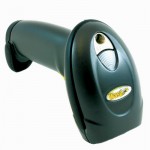Wasp Barcode Technologies: The Barcode Solution People
Do You Need a Corded or Cordless Barcode Scanner?
Sometimes after determining the
barcode scan engine and
scanner type, users need help deciding whether to purchase a corded or cordless barcode scanner. There are several factors to consider, including how you will use the device.
For example, retailers may use an in-counter scanner for point-of-sale transactions and a handheld scanner to take inventory. Therefore, they may purchase both corded and cordless scanners.
[caption id="attachment_3391" align="alignright" width="150"]

The Wasp WLS9500 is a corded, general-purpose barcode scanner that is ideal for office, retail, and warehouse applications.[/caption]
Other considerations include:
- Connectivity - What connectivity types are available in your business?
- Infrastructure - Does your organization have a network in place for wirelessly submitting data? What existing systems does the scanner need to integrate with?
- Transmission - Do you require immediate access to information such as inventory counts, or can you wait and transmit data overnight? How close (or far) will you be from the transmitter when scanning?
- Budget - How much money is allocated for your barcode solution?
- Industry - Do you have any requirements specific to your industry or environment?
Compare corded and cordless barcode scanners
The table below compares the pros and cons of
corded and
cordless barcode scanners by providing a high-level overview of each. Review it to learn more, and then call us at 1.855.484.8149 for assistance selecting the right barcode scanner for your specific needs.
|
COMPARE SCANNERS
|
|
|
Corded
|
Cordless
|
|
How They Work
|
- Communicates directly to a computer via an interface cable (usually USB)
- Supports common interfaces including USB, corded PS/2 (keyboard wedge), corded and serial RS232
|
- Uses Bluetooth and radio technologies to wirelessly communicate with a base station, which connects to a PC using a cable
- Batch memory – stores information in internal memory and sends it either in real time or when the scanner returns to its cradle
- Direct pairing – pairs directly with another device without placing it in the cradle
|
|
Pros
|
- Offers proprietary connections on certain models
|
- Provides instant access to information
- Is ideal for most applications
- Doesn’t require a wireless computer
- Won’t impact existing software systems
|
|
Cons
|
- Cords can cause scanners to fail and are not always safe
- Limited to the length of the scanner’s interface cable
- No real-time access to data
- Have to bring the items to the scanner for reading
|
- Doesn’t work when out of range
- Costs slightly more than corded scanners
|
|
Industries
|
- Manufacturing
- Retail
- Grocery stores
- Warehouses
- Healthcare
- Logistics
|
- Retail
- Warehouses
- Healthcare
- Manufacturing
|



